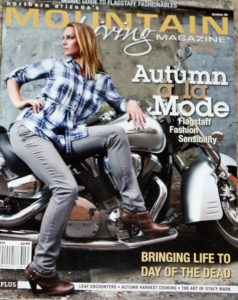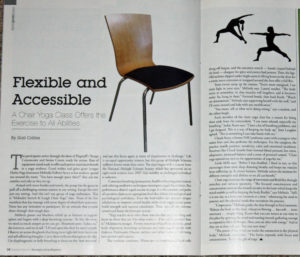![]() October 2009
October 2009
 The participants arrive at Thorpe Community and Senior Center, ready for action. Bins of equipment stand ready to offer each person maximum benefit in a yoga workout. Good wishes and grins greet Iyengar Hatha Yoga Instructor Melinda DeBoer-Ayrey as her students spread out around the room. “You have enough space there?” they ask one another and joke as they set up.
The participants arrive at Thorpe Community and Senior Center, ready for action. Bins of equipment stand ready to offer each person maximum benefit in a yoga workout. Good wishes and grins greet Iyengar Hatha Yoga Instructor Melinda DeBoer-Ayrey as her students spread out around the room. “You have enough space there?” they ask one another and joke as they set up.
Armed with water bottles and towels, the  group has the gusto to pull off a challenging exercise routine in any setting. Except this isn’t just any setting. And this isn’t any group of yoga enthusiasts. This is Melinda’s Stretch & Laugh Chair Yoga class. Three of the five members that day manage with some degree of wheelchair assistance. None has any hesitation to participate. It’s an attitude that propels them through their tough days.
group has the gusto to pull off a challenging exercise routine in any setting. Except this isn’t just any setting. And this isn’t any group of yoga enthusiasts. This is Melinda’s Stretch & Laugh Chair Yoga class. Three of the five members that day manage with some degree of wheelchair assistance. None has any hesitation to participate. It’s an attitude that propels them through their tough days.
Melinda passes out blankets rolled up as bolsters to support spines and begins with a deep breathing exercise. “At this elevation, we need as much oxygen as we can get. Mountain pose, Tadasana,” she instructs, and we sit tall. “Lift and open the chest for more oxygen. Observe air across the glands that bring more right-left brain harmony and self-affirming thoughts. Carry these with you throughout the day. Use diaphragmatic or belly breathing to focus on the ‘now moment’ and use this focus again at times of sleeplessness or challenge.” Life is an equal opportunity stressor, but this group of Multiple Sclerosis sufferers knows more than most. The class began with a request from the National Multiple Sclerosis Society which has sponsored six to eight-week sessions since 2007. Any stability or challenged individual is welcome.
Conscious breathing (pranayama), health-enhancing poses (asana) and calming meditative techniques encompass yoga’s foundation. But performance doesn’t equal success in yoga. It is the mindset and perks of a position done at an appropriate level that deliver physiological and psychological confidence. Even the bed-ridden can practice deeper inhalations to improve overall health while chair yoga’s seated poses build strength and increase circulation. These nourish the nervous system and boost the immune system.
“Yoga teaches us to relax those muscles that aren’t working and focus on those that are. Use what works – if we use it, we won’t lose it,” Melinda encourages. Twenty-two years of teaching stretches, good body alignment, breathing techniques and centering to people with diabetes, Parkinson’s Disease, asthma and other issues of well-being have proven such success.
The workout continues. Warm-ups of shoulder and head rolls shrug off fatigue, and the executive stretch –hands clasped behind the head – elongate the spine and correct bad posture. Then, the legs. Old neckties slipped under thighs assist in lifting knees to the chest for a sciatic nerve extension or wrapped around the foot offer a full flex.
Torso twists ramp up the routine. “You’re more energized, I see more light in your eyes,” Melinda says. Lateral reaches. “The body starts to remember, so that muscles will lengthen, and it becomes easier. So, hang in there.” Forward bends, and then back bends. “Watch me demonstrate,” Melinda says supporting herself with the wall, “and I’ll come around and help with any modification.”
“You mean, tell us what we’re doing wrong,” says a student, and the others laugh.
Each member of the chair yoga class has a reason for being there aside from the camaraderie. “I am more relaxed, especially my breathing,” Jackie Reyes says. “I have a lot of breathing problems, and I get fatigued. This is a way of keeping my body up.” Joan Langdon agreed, “This is something I can take home with me.”
Chuck Avery, a former NAU professor, came with a caregiver who assists him and also performs the techniques. For the caregiver, the practice instills patience, sensitivity, calm and emotional steadiness. Receivers like Chuck benefit from lowered blood pressure, less stress, adaptivity, increased balance and a sense of personal control. “Chair yoga opened my eyes to the opportunities of yoga for me.”
Linda Mills says, “Before I was disabled, I liked to run, so this encourages those same deep cleansing breaths and keeps my muscles from stiffening up. It creates balance. Melinda tailors the motions for different strengths and abilities so we all can benefit.”
Chair yoga increases the range of movement and flexibility through stretches and reduces spasticity. “The focused consciousness and concentration turns on the reward circuitry in the brain which keeps the mind mobile as well as keeping the body flexible,” says Melinda. “Still, it’s one day at a time, one moment at a time,” referencing the need to practice and the physical needs that necessitate the practice.
“Corpse pose.” Melinda guides the class through its final moments. “Release the body to the chair, relaxation flowing…face soft…inner sanctuary…simply being. Know that you can return at any time to this place by quieting the mind and turning inward, gathering courage to respond to life’s challenges. Now, you are alive with energy.” And so they are as they call out, “See you next time.”
“The power of the mind can make the connection to the physical body,” Melinda concludes. “The brain expands with focus and concentration. This is the gift of yoga.” NAMLM
